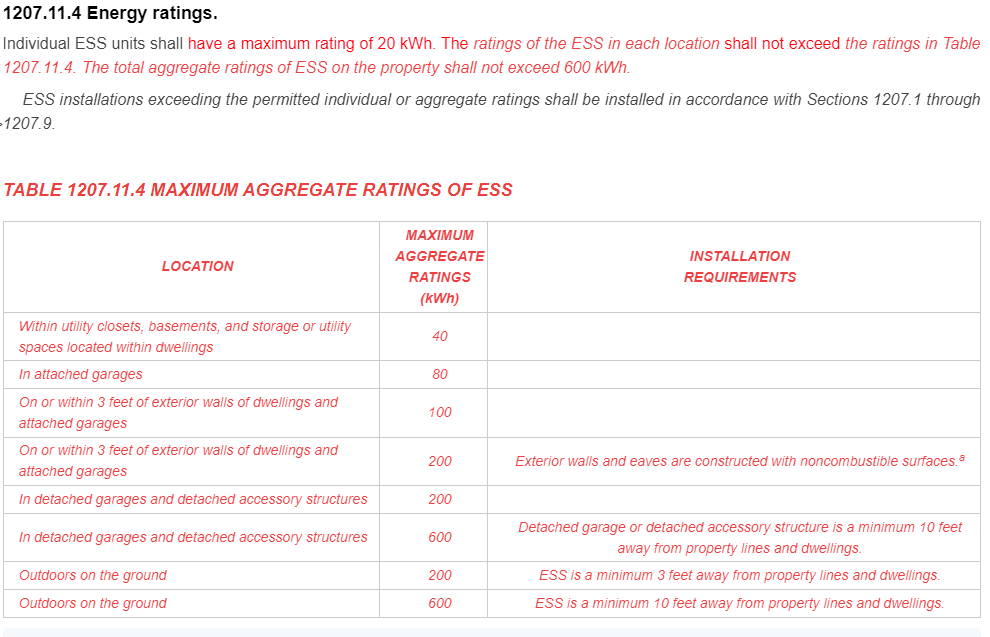New Residential Battery Energy Storage Code
Increases Limits Up To 600 kWh per Property
Finally, some good news from an unlikely area, for an industry beleaguered with cascading issues. The California Fire Code (CFC) has been updated to clarify language and significantly increase the maximum of aggregate Energy Storage Systems (ESS) for residences covered under CFC Chapter 12, section 1207.11.4.
Impact - Why This is Important
With the rollout of the California Public Utility Commission’s NEM 3.0 energy tariff and pricing last April, residential energy storage became an increasingly important part of a smart home energy management strategy. Battery storage prices have dropped considerably over the past year, allowing consumers to install larger systems to offset increasing utility energy prices – in theory, anyway. One set of regulations – the California Fire Code – has impeded larger battery installations in residences for years, making it hard to go all electric in a home greater than 4000-5000 sq. ft. with sufficient resiliency.
We have worked on numerous projects where the client wanted a certain energy outcome, while living within the building and fire codes along with city/township ordinances. We found that these were often at odds with the stated net zero, all electric goals established by bureaucrats, and sometimes our clients needed to consider sacrificing some of their energy resiliency or lifestyle objectives. It was, at times, very frustrating to say the least.
Palo Alto, CA.
As an example, we worked on a new Palo Alto residence for a tech CEO where the client wanted to go all electric, add 3 fast EV chargers, maximize their rooftop solar and battery storage, and have a standby generator as a backup to PG&E’s unreliable power delivery. We did our load calculations with all their appliances, induction cooktops, heat pumps, pool and spa pumps and heaters, outdoor heaters, wine cellar and on and on. You get the picture.
When we rolled all this up, we suggested sizes for the main service panel, solar array, battery storage and generator, along with smart circuit breakers for intelligent load shedding, as the best way to accommodate the client's choices and lifestyle objectives.
As the GC started outlining what he was looking to get permitted, he ran into a brick wall of bureaucracy; No gas generators allowed, you cannot put that much solar on your roof, limiting the amount of battery storage on the property, all due to current building and fire codes and local special ordinances. Something had to give, and it was not going to be the codes or ordinances. With these latest changes in the ESS code, they will have fewer challenges meeting their design objectives today.
Atmospheric Rivers, a.k.a. The Pineapple Express
Another impact occurred just a couple of miles up the road in Menlo Park, CA., where many estate homes have basements, was the devastation wrought by the atmospheric rivers which slammed Northern California in the winter of 22/23.
Most of Silicon Valley and the Bay Area were without PG&E power for 3 days or more, and even those with Solar were getting little to no production to charge what turned out to be undersized battery storage systems, along with a lack of generators, for this prolonged outage. For those estates that did not plan adequately, which has an average elevation of 8’ above sea level, the basement sump pumps soon ran out of battery power to keep up with the deluge of rain, and their basements flooded.
We have heard anecdotally that many residents went pitchfork in hand to City Hall and some of these code deterrents were changed quickly.
How These New ESS Codes Help
Again, back to the good news and point of this article. Someone finally recognized that their left hands and right hands were inharmonious with the outcomes they desired. This inadvertently prevented homeowners from helping to achieve those desired outcomes, while also achieving their own lifestyle goals.
This first chart is the 2022 CFC Code 1207.11.4, which limits ESS on residential property. Anyone who has done any work in this area knows the limits that the Authority Having Jurisdiction (AHJ) potentially has over a project, and they have been interpreting this code restrictively, we suspect out of an abundance of caution.
2022 CFC code
Note: Sections 1207.1 - 1207.9 of the CFC are commercial requirements for ESS and are far more cumbersome and costly to implement than section 1207.11, which is strictly for residential projects.
This second chart below is the new 1207.11.4 code and as we interpret it, the new maximum ESS size is now up to 600kWh for a property. This represents an almost 3x increase over what we have seen approved and permitted on projects we have been involved with.
2022 CFC code with July 2024 supplement (new in red):
In all fairness to the Building, Fire code folks and AHJ’s, the battery world has changed so rapidly, that they and the code have been challenged to keep up. We are pleased to see that they have updated the code to meet today’s electrification reality and are providing our clients with more flexibility to meet their desired energy system goals and objectives.
Pacific Energy Advisors LLC can work with you and your architect, general and electrical contractors, owners' rep, design team and other stakeholders to pragmatically plan and design an energy system that meets your current and future needs, goals, and objectives. Whether it is a 500-acre ranch with multiple outbuilding clusters or your dream or weekend home in the United States or abroad, we can plan a system that intelligently integrates with your lifestyle, uses readily available, best in class products and we help you do it as economically as possible.
Contact the Author: Todd Wulfert - todd@pacificenergyadvisors.com




